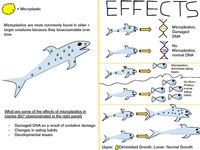
Polyethylene microplastics affect the distribution of gut microbiota and inflammation development in mice.
Sign Up to like & getrecommendations! Published in 2019 at "Chemosphere"
DOI: 10.1016/j.chemosphere.2019.125492
Abstract: Environmental pollution caused by plastics has become a public health problem. However, the effect of microplastics on gut microbiota, inflammation development and their underlying mechanisms are not well characterized. In the present study, we assessed… read more here.
Keywords: inflammation development; inflammation; microbiota inflammation; gut microbiota ... See more keywords

Assessing the role of polyethylene microplastics as a vector for organic pollutants in soil: Ecotoxicological and molecular approaches.
Sign Up to like & getrecommendations! Published in 2021 at "Chemosphere"
DOI: 10.1016/j.chemosphere.2021.132460
Abstract: Microplastics (MPs), pharmaceuticals and pesticides are emerging pollutants with proposed negative impacts on the environment. Rising interest in investigations of MPs is likely related to their potential to accumulate in agricultural systems as the base… read more here.
Keywords: assessing role; role polyethylene; microplastics vector; vector organic ... See more keywords

Sorption of organochlorine pesticides on polyethylene microplastics in soil suspension.
Sign Up to like & getrecommendations! Published in 2021 at "Ecotoxicology and environmental safety"
DOI: 10.1016/j.ecoenv.2021.112591
Abstract: As a new type of environmental pollutant, microplastics (MPs) can adsorb residual organochlorine pesticides (OCPs) in the soil and pose a severe threat to the soil ecosystems. To understand the interaction between soil MPs and… read more here.
Keywords: organochlorine pesticides; microplastics soil; soil suspension; sorption ... See more keywords

Polyethylene microplastics increase the toxicity of chlorpyrifos to the marine copepod Acartia tonsa.
Sign Up to like & getrecommendations! Published in 2020 at "Environmental pollution"
DOI: 10.1016/j.envpol.2020.114059
Abstract: Ingestion of microplastics by marine organisms has been well documented, but their interaction with chemical pollutants has not been sufficiently addressed. The aim of this study was to determine the individual and combined effects of… read more here.
Keywords: copepod; cpf; acartia tonsa; polyethylene microplastics ... See more keywords

Physiological stress response of the scleractinian coral Stylophora pistillata exposed to polyethylene microplastics.
Sign Up to like & getrecommendations! Published in 2020 at "Environmental pollution"
DOI: 10.1016/j.envpol.2020.114559
Abstract: We investigated physiological responses including calcification, photosynthesis and alterations to polar metabolites, in the scleractinian coral Stylophora pistillata exposed to different concentrations of polyethylene microplastics. Results showed that at high plastic concentrations (50 particles/mL nominal… read more here.
Keywords: scleractinian coral; response; pistillata exposed; stylophora pistillata ... See more keywords

Oxidative damage and decreased aerobic energy production due to ingestion of polyethylene microplastics by Chironomus riparius (Diptera) larvae.
Sign Up to like & getrecommendations! Published in 2021 at "Journal of hazardous materials"
DOI: 10.1016/j.jhazmat.2020.123775
Abstract: Riverine sediments are major sinks of microplastics from inland anthropogenic activities, imposing a threat to freshwater benthic invertebrates. This study investigated the ingestion of three size-classes (SC) of irregularly shaped polyethylene microplastics (PE-MPs; SC I:… read more here.
Keywords: energy; aerobic energy; oxidative damage; chironomus riparius ... See more keywords

Lipidomic analysis of single and combined effects of polyethylene microplastics and polychlorinated biphenyls on human hepatoma cells.
Sign Up to like & getrecommendations! Published in 2021 at "Journal of hazardous materials"
DOI: 10.1016/j.jhazmat.2021.126777
Abstract: Microplastics are an emerging environmental issue as a result of their ubiquity, persistence, and intrinsic toxic potential. In addition, their ability to sorb and transport a wide variety of environmental pollutants (i.e. "Trojan Horse" effect)… read more here.
Keywords: combined effects; lipidomic analysis; human hepatoma; single combined ... See more keywords

Sorption and desorption of selected pharmaceuticals by polyethylene microplastics.
Sign Up to like & getrecommendations! Published in 2018 at "Marine pollution bulletin"
DOI: 10.1016/j.marpolbul.2018.09.048
Abstract: The aim of the present study was to evaluate the sorption and desorption of sulfamethoxazole (SMX), propranolol (PRP) and sertraline (SER) by polyethylene (PE) microplastics in water. After the 96 h mixture, the sorption percentages of… read more here.
Keywords: desorption selected; sorption desorption; selected pharmaceuticals; sorption ... See more keywords

Polyethylene microplastics interfere with the nutrient cycle in water-plant-sediment systems.
Sign Up to like & getrecommendations! Published in 2022 at "Water research"
DOI: 10.1016/j.watres.2022.118191
Abstract: Increasing microplastic (MP) pollution and its effects on aquatic systems have become a global issue; however, the impact of MPs on biogeochemical cycles is poorly understood. A simulation study was performed to analyse the influence… read more here.
Keywords: nutrient cycle; cycle; polyethylene microplastics; water ... See more keywords

Revealing the Mechanisms of Polyethylene Microplastics Affecting Anaerobic Digestion of Waste Activated Sludge.
Sign Up to like & getrecommendations! Published in 2019 at "Environmental science & technology"
DOI: 10.1021/acs.est.9b02971
Abstract: Polyethylene (PE) microplastics retained in sewage sludge inevitably enter the anaerobic digestion system. To date, no information has been reported on the mechanisms of PE microplastics affecting anaerobic digestion of waste activated sludge (WAS). This… read more here.
Keywords: affecting anaerobic; sludge; anaerobic digestion; polyethylene microplastics ... See more keywords

Exposure to polyethylene microplastics alters immature gut microbiome in an infant in vitro gut model.
Sign Up to like & getrecommendations! Published in 2022 at "Journal of hazardous materials"
DOI: 10.2139/ssrn.4229664
Abstract: Infants are characterized by an immaturity of the gut ecosystem and a high exposure to microplastics (MPs) through diet, dust and suckling. However, the bidirectional interactions between MPs and the immature infant intestinal microbiota remain… read more here.
Keywords: exposure polyethylene; gut microbiome; microplastics alters; polyethylene microplastics ... See more keywords